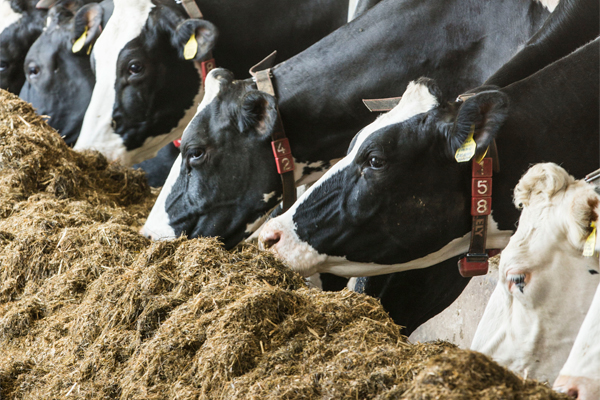Uniformity is key in feed intake of dairy cows

Dry matter intake is very important for high producing dairy cows. Quality of the feed is important but also the uniformity of the feed consumed by the animals.
By Kevin T. Leahy, dairy
technical service specialist, Diamond V
Before we discuss how we can improve dry matter intake (DMI) in dairy cattle we might ask, “Why is it important?” Milk production and milk components pay the bills on a dairy so improving DMI, especially in early and high-producing cows is required to get that done. Excessive body weight loss, especially in fresh cows, can lead to health and reproductive problems that can adversely affect the profitability of a dairy. Total Mixed Ration (TMR) ingredient costs have trended much higher over the last several years, therefore, the need to manage refusal in order to not “waste” feed has also become important.
Negative energy balance
Cows reach peak dry matter intake between 10 to 13 weeks after calving. At this time she should be consuming approximately 4% of her body weight. For much, if not all, of this time she will be in negative energy balance. Maximising intake during this time can mitigate the extent of negative energy balance of the cow allowing for increased production, improved reproduction and better animal health. High producing dairy cows are often the most susceptible to metabolic and physiological diseases during this time. Wallace et al. (1998) monitored 48 cows (46 completed the study) for the first 20 days after calving. In Figure 1, we see that cows designated as “Healthy” (no event) ate significantly more (P<.05) than those that were "sick" with an event such as a retained placenta (rp), metritis (met), ketosis, (ket) or a displaced abomasum (da). at certain times during the first 20 days, the healthy cows ate nearly 6.8 kg more.>
Not surprisingly the milk production for the Healthy cows, shown in Figure 2, was significantly greater (P<.05) that of the sick cows, approximately 9 kg more. cows don't particularly like change especially as it relates to their daily ration. decreasing the amount of variation in a diet provides a more consistent ration to the cows and a ration that is not changing in nutrient content. one way to insure better dmi is with a more consistent tmr. a tmr audit™ is an on-farm evaluation of the feed storage and preparation, the mixing and delivery of the tmr, the measurement of the ingredient variation and shrink, and utilisation of the labour and resources required to mix and deliver the feed.>
Tool for uniformity
Use of the Penn State Particle Separator (PSPS) is a good tool to monitor both within-batch and between-batch variation of particle size in TMRs and allows for the more immediate on-farm assessment of uniformity. The procedure for using the PSPS includes the following steps: 1) Sample TMR/PMR immediately after it is delivered to the feed bunk and before cows start consuming the ration. 2) Scoop up approximately 500 grams of TMR and place it in a litre Ziploc bag. 3) Obtain samples along the feed bunk representing the beginning, middle, and end of the TMR/PMR load. 4) Shake the sample through the PSPS and make certain smaller particles that are clumped together with any added liquids are filtered through the top screen and 5) Calculate the percentage weight (as-is basis) on each screen and determine the co-efficient of variation (CV) for the batch.
Collection of TMR analyses
The goal is to have < 3% CV on each screen. Variation should be assessed on those screens where most of the ration is collected. In the US the middle and bottom screens of the PSPS can be used to make on-farm assessments of within-batch variation, while in Europe all three screens can be used. Over 1000 of these TMR analyses have been conducted and compiled throughout the United States by trained representatives of Diamond V over the past 6 years, over 370 of these analyses included data as to the specific items in the mixing process that were identified as causes of variation. Figure 3 shows that less than 30% of these TMR audits had no issues while over 20% of the variation that occurred in TMRs was due to worn parts in the mixer.
Effect of auger speed
Most often worn knives and worn kicker plates were identified as the cause of variation in the TMR. Regular inspection of these parts, ideally monthly, but at least quarterly is recommended. Be sure to remove foreign materials from these augers at the same time. Proper mixing time and hay processing can both significantly affect proper mixing of the ration as well. More recently proper auger speed, measured as revolutions per minute (RPM), was identified as a cause of feed variation. Auger speed had a dramatic effect on dry matter intake (Figure 4) and milk production. The cause of the drop in DMI and milk production was a change in the gearbox on the mixer wagon. An old one-speed gearbox was replaced with a new two-speed gearbox, but the new gearbox was first set in first gear. This decreased the RPM from 42 RPM with the old gearbox to 28 RPM with the new one. This coincided with the drop in DMI. After a TMR Audit™ was conducted and this discrepancy was noted the new gearbox was changed to 2nd gear. This change resulted in the RPM increasing to 38 RPM with a corresponding increase in both DMI and milk production.
Conclusion
Monitoring and correcting for proper mixing of a TMR is a good practice to provide a consistent ration to your dairy cows. Along
with regular maintenance of the mixing equipment.
References are available on request.
[Source: AllAboutFeed magazine Vol 22 nr 4, 2014]











